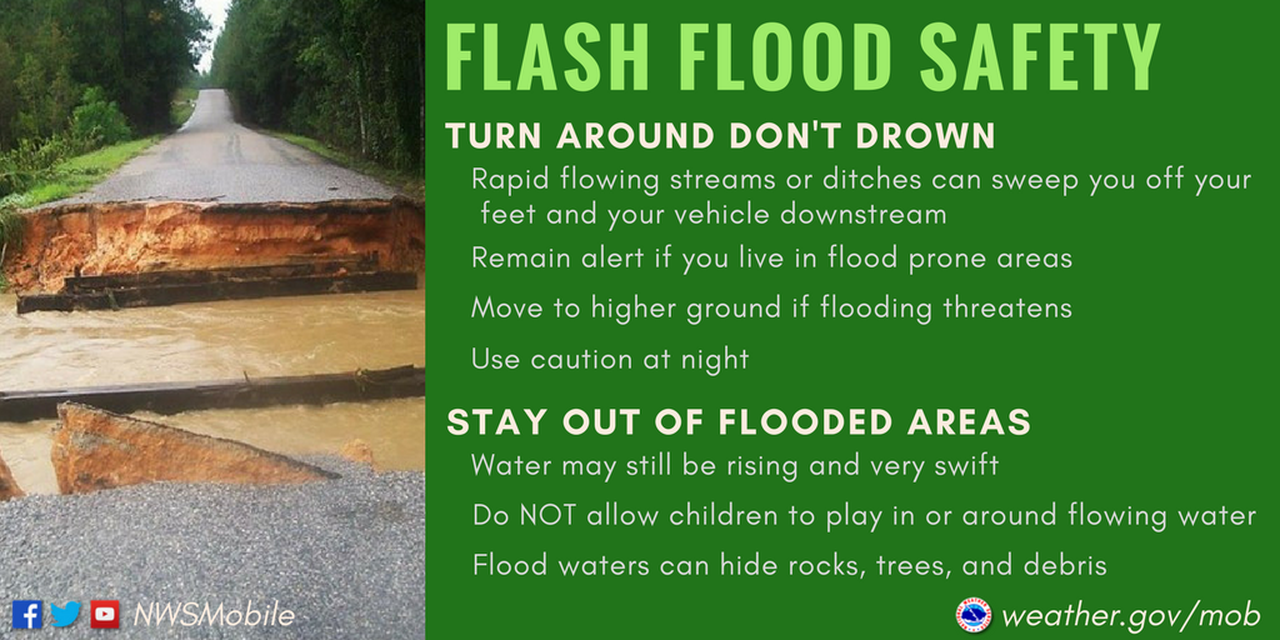Flash Flood Emergency: What To Know And How To Stay Safe

Table of Contents
Understanding Flash Flood Risks
Flash floods, characterized by a rapid and sudden rise in water levels, pose a significant life-threatening hazard. Recognizing the warning signs and identifying high-risk areas are crucial for minimizing your risk.
Identifying Flash Flood Warning Signs
Several indicators can signal an impending flash flood. Be vigilant and take action if you observe:
- Rapidly rising water levels: Noticeable increases in water levels in streams, rivers, creeks, or even normally dry areas.
- Sudden increase in water flow: A dramatic change in the speed and volume of water movement.
- Heavy or continuous rainfall: Prolonged periods of intense rainfall, especially in areas with poor drainage.
- Muddy water: A significant change in water color indicating sediment runoff.
- Debris flowing in the water: Branches, logs, and other debris carried by the swift current.
- Changes in water color or unusual sounds: Unusual sounds like roaring or gurgling from normally quiet streams.
These signs indicate that a flash flood may be imminent, requiring immediate action.
High-Risk Areas
Certain locations are inherently more vulnerable to flash floods. Familiarize yourself with these high-risk zones:
- Low-lying areas: Areas situated in valleys or floodplains are particularly susceptible.
- Areas near rivers, streams, and canyons: Proximity to water sources increases the risk of rapid inundation.
- Areas with steep slopes: Steep terrain can channel water quickly into lower areas.
- Areas with poor drainage: Locations with inadequate drainage systems are more prone to flooding.
- Areas with a history of flash flooding: Check local flood risk maps and historical data to identify areas with a history of flash floods. Many municipalities provide these maps online.
Preparing for a Flash Flood Emergency
Proactive preparation is key to mitigating the risks associated with flash floods. This involves developing a comprehensive family emergency plan and taking steps to protect your property.
Developing a Family Emergency Plan
A well-defined family emergency plan is crucial for coordinating actions during a flash flood:
- Establish a meeting place: Designate a safe meeting point outside the flood-prone zone.
- Identify evacuation routes: Plan multiple escape routes from your home, considering different scenarios.
- Prepare an emergency kit: Assemble a kit including water, non-perishable food, a first-aid kit, essential medications, important documents, flashlights, and extra batteries.
- Designate an emergency contact: Choose someone outside the affected area to contact in case of separation.
- Learn basic first aid and CPR: Knowing these skills can be life-saving in emergency situations.
Protecting Your Property
Taking preventative measures can minimize property damage during a flash flood:
- Elevate valuable items: Move important possessions to higher levels or waterproof containers.
- Move furniture and appliances: Relocate furniture and appliances away from potential flood zones.
- Clear gutters and drains: Regularly clean gutters and drains to ensure efficient water flow.
- Consider flood insurance: Explore the possibility of obtaining flood insurance for added protection.
- Know how to turn off utilities: Learn how to quickly shut off gas, electricity, and water supplies in an emergency.
Responding to a Flash Flood Emergency
Swift and decisive action is paramount during a flash flood emergency. Evacuating your home and staying safe are critical priorities.
Evacuating Your Home
Immediate evacuation is crucial upon receiving an official warning:
- Heed evacuation warnings: Never ignore official warnings; evacuate promptly.
- Never drive through floodwaters: Even shallow water can sweep a vehicle away. "Turn around, don't drown!" is a critical reminder.
- Do not walk or swim through floodwaters: Floodwaters are often contaminated and contain unseen hazards.
- Seek higher ground: Move to elevated areas away from the flood zone.
Staying Safe During a Flash Flood
While evacuating, stay informed and maintain awareness:
- Monitor weather reports: Keep a close watch on weather updates and forecasts.
- Listen to local news and emergency alerts: Stay informed about the evolving situation.
- Stay away from floodwaters: Avoid contact with floodwaters at all costs.
- Be aware of potential hazards: Watch out for downed power lines and other dangers.
- If trapped, seek refuge: If trapped indoors, move to the highest floor or roof and signal for help.
Recovering After a Flash Flood
Post-flood recovery requires careful assessment and safe cleanup procedures.
Assessing Damage
After the floodwaters recede, carefully assess the damage:
- Check for structural damage: Inspect your home for cracks, foundation damage, or other structural problems.
- Inspect for electrical hazards: Avoid contact with any electrical wiring or appliances until inspected by a qualified professional.
- Avoid contact with floodwaters: Floodwaters are often contaminated with sewage and hazardous materials.
- Report damage: Contact your insurance company and local authorities to report damages.
Cleaning Up Safely
Cleaning up after a flash flood requires caution and safety precautions:
- Wear protective gear: Use gloves, boots, and protective eyewear.
- Use caution when handling contaminated materials: Dispose of damaged items properly.
- Discard damaged items appropriately: Follow guidelines for hazardous waste disposal.
- Dispose of flood debris safely: Don't overload landfills; follow local regulations.
- Be aware of the risk of mold and mildew: Quickly address any signs of mold or mildew to prevent further damage.
Conclusion
Flash flood emergencies demand vigilance, preparation, and swift action. Recognizing warning signs, developing a comprehensive flash flood emergency plan, and understanding safe evacuation procedures are crucial for mitigating the risks. Ignoring flash flood warnings can have life-threatening consequences, as attempting to drive or walk through floodwaters is incredibly dangerous. Stay safe this season by prioritizing flash flood safety and preparedness. Develop a comprehensive plan and be ready to respond to a flash flood emergency! By being informed and prepared, you can significantly reduce your vulnerability to the devastating effects of flash floods.

Featured Posts
-
 Laurent Baffie Et Thierry Ardisson Un Mea Culpa Et Ses Consequences
May 25, 2025
Laurent Baffie Et Thierry Ardisson Un Mea Culpa Et Ses Consequences
May 25, 2025 -
 Increased Retail Sales Reduce Probability Of Bank Of Canada Interest Rate Reduction
May 25, 2025
Increased Retail Sales Reduce Probability Of Bank Of Canada Interest Rate Reduction
May 25, 2025 -
 Escape To The Country Balancing Rural Life With Modern Amenities
May 25, 2025
Escape To The Country Balancing Rural Life With Modern Amenities
May 25, 2025 -
 Post Trump Tariff Announcement Euronext Amsterdam Sees 8 Stock Surge
May 25, 2025
Post Trump Tariff Announcement Euronext Amsterdam Sees 8 Stock Surge
May 25, 2025 -
 Ces Unveiled Europe A Amsterdam Un Apercu Des Innovations Technologiques
May 25, 2025
Ces Unveiled Europe A Amsterdam Un Apercu Des Innovations Technologiques
May 25, 2025
